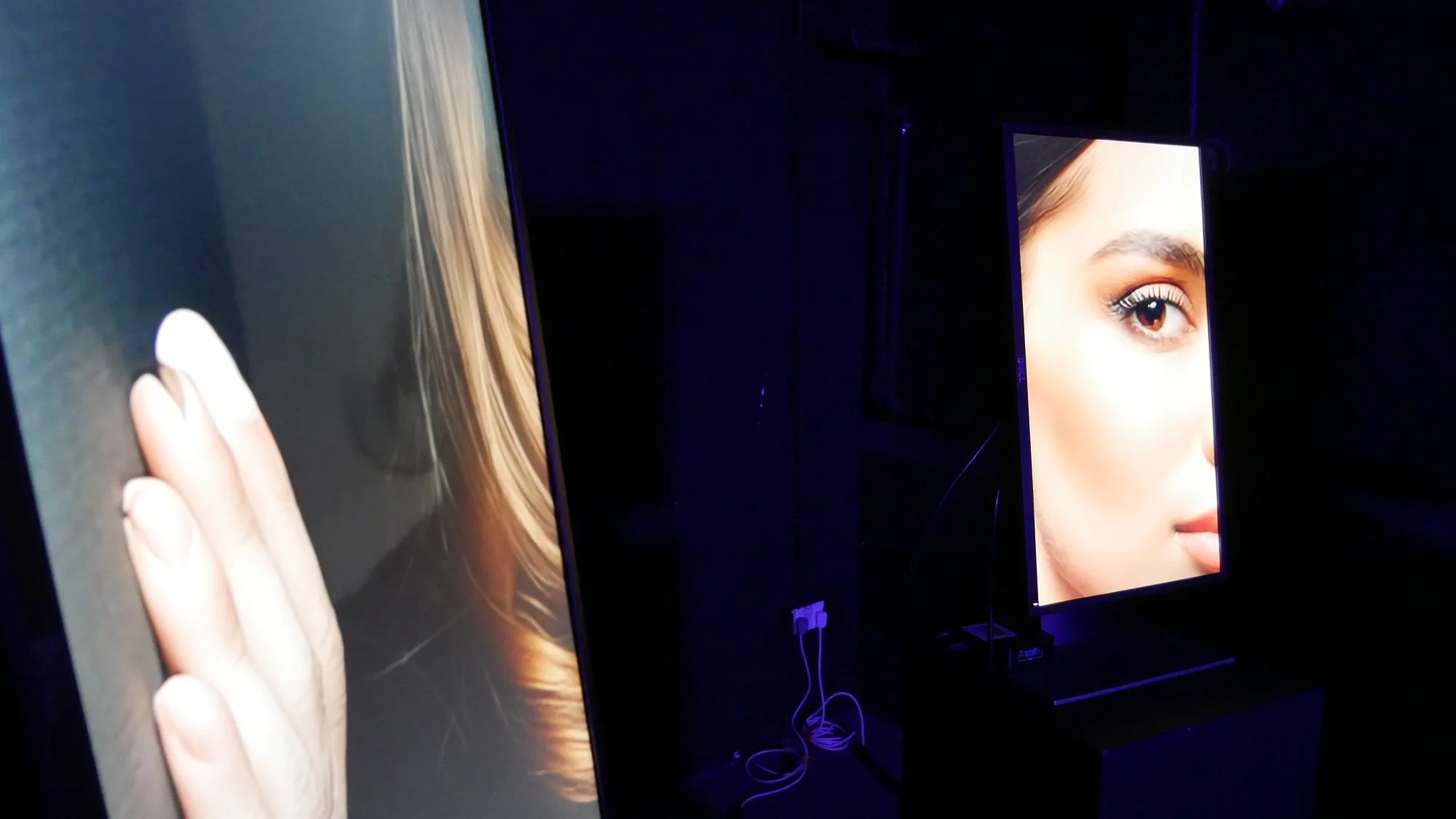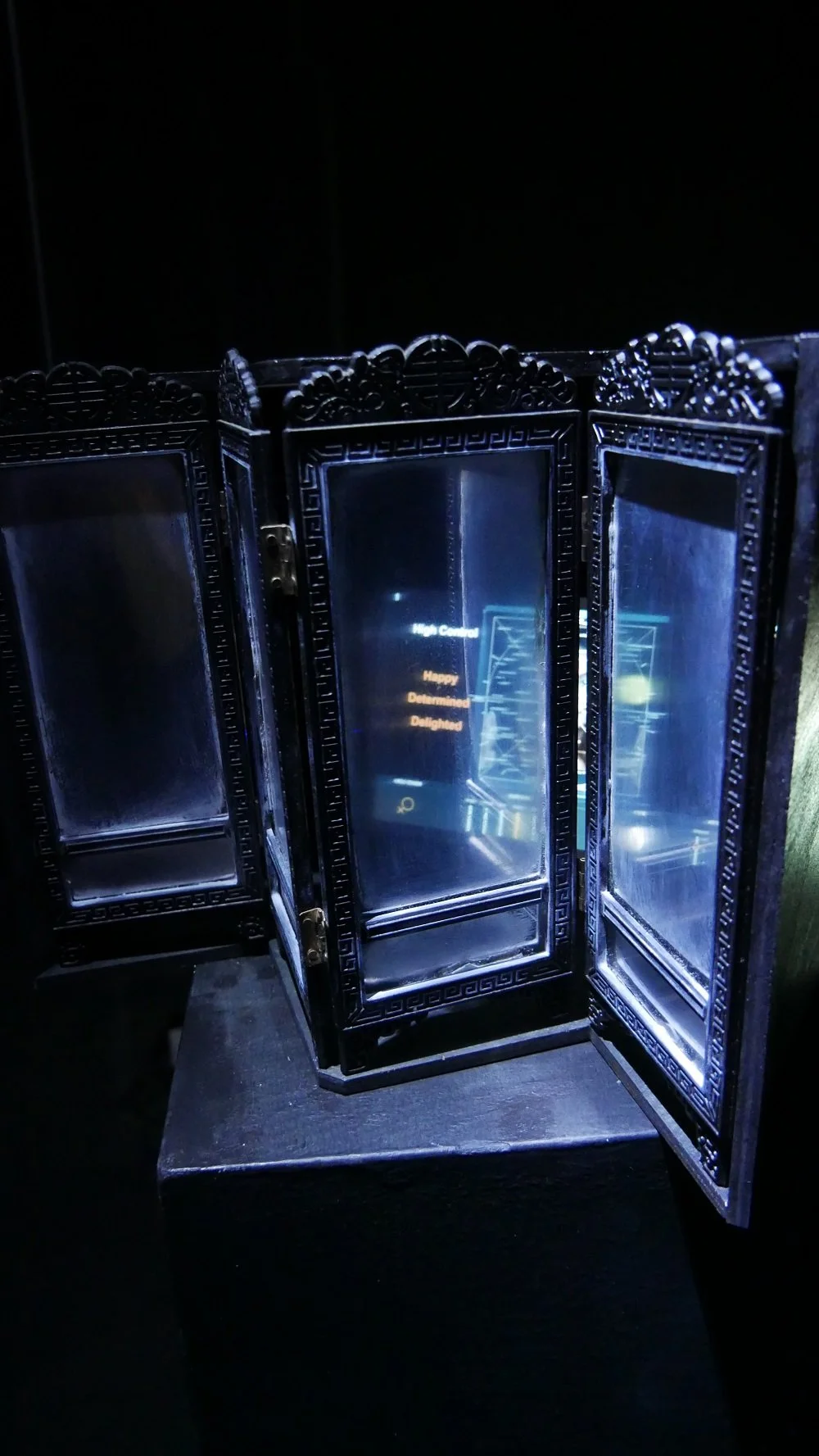Kin>% on Digital Fatalism, Hidden Labor, and the Politics of AI
By Cansu Waldron
Kin>% (cell_less) is a UK-based PhD artist-researcher whose practice investigates narratives of technological inevitability and the ways algorithmic systems make decisions for and about us. Working across sound, installation, moving image, and interactive digital media, her work invites audiences to question the politics of technology and its role in shaping identity, agency, and perception.
Kin designs installations that emerge from their environment, often combining contemporary technologies like motion sensors, digital software, and tracking devices with recycled, repurposed, and sustainable materials. By incorporating techniques from interaction design, she draws audiences into immersive experiences that examine how we use our bodies to navigate space. These works often unfold as fragments of stories, inviting viewers to participate and reflect on the social and environmental consequences of human action (or inaction).
Her art is marked by a sustained interest in our treatment of natural resources, shifting understandings of “nature,” and the ways environments mediate relationships between people. Rooted in both critical theory and poetic inquiry, Kin’s practice bridges technology and ecology — exploring how movement, interaction, and presence can become forms of awareness in a rapidly mechanized world.
Her projects have been exhibited internationally, including at the Wrong Biennale, Peckham Creative Computing Festival, CCA Glasgow, Radiophrenia, and Artech, among others. As a writer, she has contributed to Corridor8, AI & Society Journal, Byline Times, Disability Arts Online, and CultBytes, extending her critical inquiry into digital culture through both visual and textual forms.
We asked Kin about her art, creative process, and inspirations.
Can you tell us about your background as a digital artist? How did you get started in this field?
As long as I can remember, I’ve always been curious about how technologies work, digital and analogue. I was always trying to take things apart and find a way that I could be creative with them. I started messing around with Arduino in 2011 as a way to incorporate proximity sensors and interactive buttons into my work. I always felt resistant to the idea of the singular artist as this revered figure whose status is elevated above the audience. So, I was drawn to the contrary: interactive and participatory approaches that embraced the public as almost co-creators. The work wouldn’t exist without some form of input from people other than me. I think I’m less dogmatic about this now (especially after reading Claire Bishop’s Artificial Hells), but it’s still an idea that resonates with me.
Digital tools present a lot of scope for public interaction and exploration. They also fit well with actions of concealment, disguise and multiple identities, again challenging that idea of the singular artist-as-author. I’ve always felt more ‘myself’ when using multiple pseudonyms and aliases. In this sense, digital for me can be quite fluid and liberating, as opposed to the dominant internet infrastructure which I talk about below.
You describe your work as exploring narratives of technological inevitability. What first drew you to question this idea, and how do you see it playing out in everyday life?
I started to see my work in terms of how it exposed and challenged narratives of technological inevitability in 2019-20 when I was developing my PhD proposal. Previously, I’d always linked my work to critiques of digital surveillance. I was compelled to create work that drew attention to the links between surveillance and communications technology (for example, seeing social media platforms as data-gathering/surveillance tools for private companies). When I was drafting my proposal, I asked myself, ‘What is it that really bothers me about this? Why do I keep returning to these themes?’ And my answer lay in this sense of inevitability that is cultivated by surveillance and prediction technologies, but also by automated decision-making, AI and machine learning technologies, and the PR narratives and hype that companies circulate that attempts to shape public perception. It is, what I call, Digital Fatalism.
Of course, these are different types of inevitability but I could see this connection between them. On the one hand you have inevitability in a personal sense (i.e. data surveillance that makes inescapable, incontestable judgements about you as a person) and on the other hand, there is inevitability in a societal sense (i.e. our societies are dependent on these technologies and that is just the way it is). That is when it fell into place for me. In a way, it’s a continuation of Foucault’s disciplinary power and it’s important because it is a strategy of control.
Many of your projects use sound and moving image alongside interactive technologies. How do you decide which medium best tells a story?
Maybe thinking in singular mediums is quite restrictive. We don’t experience the world like that. We tend to have much more multi-sensory experiences. Some might argue that there is a focus on the visual, but listen to a horror film with the sound off and it has no way near the same effect. I like to think in terms of combinations of different media, for example, with one of the digital sculptures in the Dissimulation exhibition, I used a video screen behind a one-way mirror. It was this pairing that was most important to me.
A one-way mirror has been called upon as a metaphor to describe our interactions with online platforms: they reflect us back at ourselves while gathering data about us behind-the-scenes. We’re shut out of that process, and that creates a huge power imbalance.
The video on the screen was playing a digital collage of emotion-tracking surveillance tools. One was for employers conducting Zoom-style interviews, and as the interviewee was applying for the job, the employer would run an emotion-tracking service which would judge how ‘honest’, ‘genuine’, ‘confident’, etc the candidate was being. In that situation, the person applying for the job is completely unaware of the technologies being used to make assessments about their character. They might see the interviewer’s face in the online meeting but the screen hides so much. I think this is why I keep coming back to screens and moving images, because they are as much portals as they are closed doors.
In your view, what’s the most subtle way algorithmic technologies are already making decisions for us?
It’s a difficult question because it relies on investigative journalism and research to reveal the extent of how these technologies are being used. The Public Law Project has done great work exposing how pervasive these kinds of technologies are in UK governmental departments, finding algorithmic technologies making damning decisions that affect people’s lives through, for instance, access to housing, benefits, and identifying children at risk of being placed in care. 80% of the technologies documented in their database were only revealed through Freedom of Information requests and many are low transparency in terms of information that is publicly available as to how they work and are being used.
Your recent exhibition Dissimulation (Newcastle University, 2025) suggests layers of hiding and revealing. What ideas were you “dissimilating,” and how did audiences respond?
I chose the title Dissimulation because it describes the process of using false appearances to hide a form of reality. It brings to mind a sense of trickery and illusion, which I think is quite apt when we are thinking about what is often called Artificial Intelligence. When general publics interact with technology like a chatbot or an image generator, all of the human labour that has produced them is invisible. I don’t just mean it’s invisible at that moment. It is made invisible through the discourse that companies use to frame their products.
Take AI Agents, for example. When something is called an Agent, it creates a sense of an individual entity with autonomy. It forefronts that singularness over the extensive infrastructure, resources, labour, and so on that is essential to its being. Of course, this is not unique to AI or any other technology. Processes of commodification, of any product, emerge from alienated labour and workers being separated from the thing they are making. Whereas there is a general awareness of the labour required to manufacture a car, for example, there is much less awareness of the role of clickworkers in AI.
What I was trying to reveal through the main video installation is the hidden labour that goes into AI. To do this, I attempted to connect the dots between clickworkers who are labelling the data, the images of people that are contained within the datasets, and general social media users and content creators that maybe don’t see themselves as data workers but who very much are.
One of the consequences of emphasising the ‘agent’ framing of AI is that is diminishes perceptions of how we, as a society, can shape and affect it. As I see it, there is an ideological motivation to conceal the labour that goes into AI because by doing so, it makes this technology appear incontestable, unchallengeable and beyond our influence. It fosters a general acceptance of the current dominant systems.
As both an artist and researcher, how do writing and making feed into each other?
I think I like writing about other people’s work more than my own. I make sure to publish several reviews of exhibitions a year as I find that writing helps me to digest the ideas after seeing a show. The latest review I wrote was published in Corridor8, which is a brilliant journal for arts criticism in the North East of England. Writing really helps me focus and organise my thoughts, and often I’ll have new ideas for artworks when finishing an article.
What role does speculation or imagination play in your work, especially when confronting technological systems that can feel so opaque?
I think there is an important role for artists to ‘bear witness’ to injustice wherever it occurs, to borrow a phrase from the artist Philip Guston. I remember being moved by his exhibition at Tate Modern in 2024. From a family of Jewish migrants who moved to Canada to escape antisemitic persecution, he started making political art in LA in the 1930s amidst the rise of the KKK in the US and Nazism across Europe. He then made a lot of abstract art, which went down well with the critics, but he was compelled to return to making images of the Klan, this time using satire and ridicule challenge racist ideology and institutions. Speculation and imagination are of course crucial to steering the future in new positive directions (to break free from the trappings of Capitalist Realism), but they can also make it easy to look the other way.






















